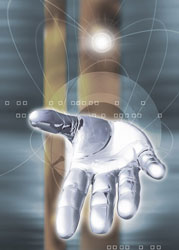When surgery enters the world of virtual reality
Despite the obvious importance of tactile cues in everyday life, tactile sensing and display for tele-manipulators, virtual reality and more generally, human-computer interfaces (HCIs) may still continue to elude researchers. The fusion of sensory data, including sound, touch and even smell could form an advanced, realistic and intuitive user interface, nevertheless current systems have relied heavily on vision feedback. The European project MULTISENSE aimed to combine different sensory devices in a unique virtual reality environment for orthopaedic surgery. For the haptic modality in particular, hardware and software were developed at the University of Salford to provide effective touch feedback that could enhance the growth of innovative medical applications. The medical user selected scenarios, in which haptic feedback to help position and orient artificial implants would be of the greatest benefit. The haptic requirements of this specific application were also defined. More specifically, research work sought to address one of the limitations towards the realisation of a portable tactile display, posed by the size and weight of current actuators. Although electrostatic and piezoelectric actuators allow for compact designs, they lack the force output needed to generate a realistic haptic sensation and more importantly, require heavy and complicated power supply. 16 miniature, direct current (DC) motors were therefore used to provide pulling forces up to 4.73N to the spring-loaded pins of the tactile display in the form of a pin array. Forces from the motors are transmitted to the pins by means of nylon tendons encased in Teflon cables, allowing for a small tactile display component to be attached at the fingertip. The motors within the drive pack are powered by a battery stack that adds a mass of 100g to the portable, wearable device total weight, which does not exceed 275g. Initial test results have indicated that all pins in the array can be displaced over 2.5mm. The bandwidth of this displacement is greater than 12Hz, which is suitable for texture simulations. This haptic device was realised to suit the workspace of a multimodal application framework and the interaction requirements of medical procedures, where surgeons would use a range of sensory cues.







